Paramedical Tattoo Training
Master the Art of Paramedical Tattooing with Illusions By Ink Studio’s Comprehensive Camouflage Tattoo Training Courses
At Illusions By Ink Studio, we provide extensive, hands-on training designed for those who aspire to become skilled professionals in paramedical tattooing. Our classes focus on camouflage tattooing, a technique used to conceal scars, skin discoloration, and various skin imperfections, allowing clients to restore confidence in their appearance. Through expert guidance and practice, our training program equips students with the knowledge and precision required to master this specialized art form and make a meaningful impact on others’ lives.
Our paramedical tattoo training covers a range of essential skills and techniques, from understanding skin types and pigment selection to applying realistic shading and blending for a seamless look. Each module is designed to ensure our students gain a deep understanding of camouflage tattooing as a craft and as a service, empowering them to take on real-world cases with confidence and compassion. With a curriculum that includes hands-on practice, our training provides the technical skills and experience necessary to succeed in the growing field of paramedical tattooing.
Choosing Illusions By Ink Studio for paramedical tattoo training means learning from seasoned professionals dedicated to advancing the field and supporting each student’s journey. As demand for camouflage tattooing grows, our program remains committed to staying at the forefront of industry trends and techniques, helping students build a fulfilling career with the latest knowledge and tools. We are proud to offer a transformative learning experience that equips students not only with advanced tattooing skills but also with the confidence to deliver life-changing results for their clients.

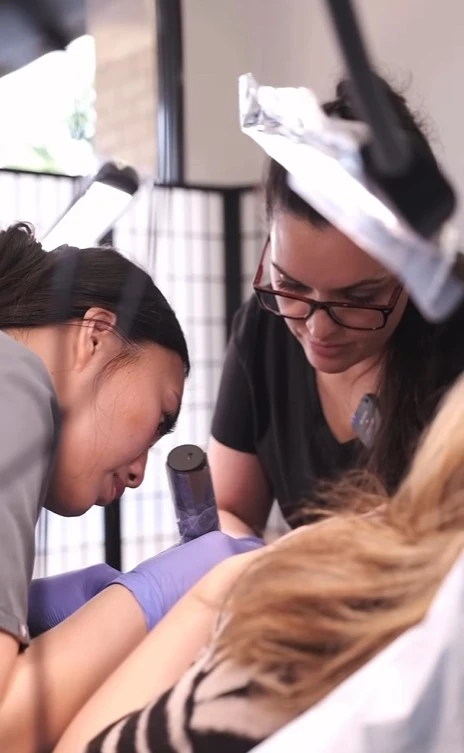

Is Paramedical Tattoo Training Right for You? Discover Who Our Program is Made For

Nurses Seeking Renewal in Medical and Aesthetic Skills
Our paramedical tattoo training program is great for nurses who want to improve their skills. It helps them start a creative and meaningful career in the medical-aesthetic field. The training is made for healthcare professionals. Nurses will learn advanced techniques to help clients feel confident again. They will master camouflage tattoos, scar reduction, and more. This program combines clinical knowledge with artistic skills. It lets nurses refresh their careers with a rewarding specialty.

Beauty Business Owners Looking to Add Transformative Services
For beauty business owners, our program offers the opportunity to add a valuable and life-enhancing service to your offerings, setting your business apart in a competitive industry. Our training equips you with the skills to introduce paramedical tattooing, allowing clients to achieve skin tone restoration, scar concealment, and realistic-looking results. This certification not only broadens your service menu but also meets the growing demand for specialized cosmetic, and beauty solutions with authenticity and care.

Permanent Makeup Artists and Estheticians Expanding Their Craft
Permanent makeup artists and estheticians will find our program a natural extension of their expertise, providing advanced techniques for skin camouflage and scar correction that enhance their existing skill set. This training prepares you to work with a broader client base, offering specialized options that go beyond beauty and into the realm of restorative services. By adding paramedical tattooing to your repertoire, you’ll become a multi-dimensional artist equipped to make a profound difference in your client’s lives.

Individuals Enchanted by the Beauty Industry with a Desire to Make a Difference
If you’re drawn to the beauty industry and want to provide meaningful, confidence-restoring services, our paramedical tattoo training is designed with you in mind. This program offers you an entry into a fulfilling career that combines artistry and empathy, allowing you to positively impact the lives of clients through skillful, compassionate care. Whether you're beginning a new career path or following a passion, this training can open the door to a rewarding profession where beauty meets purpose.
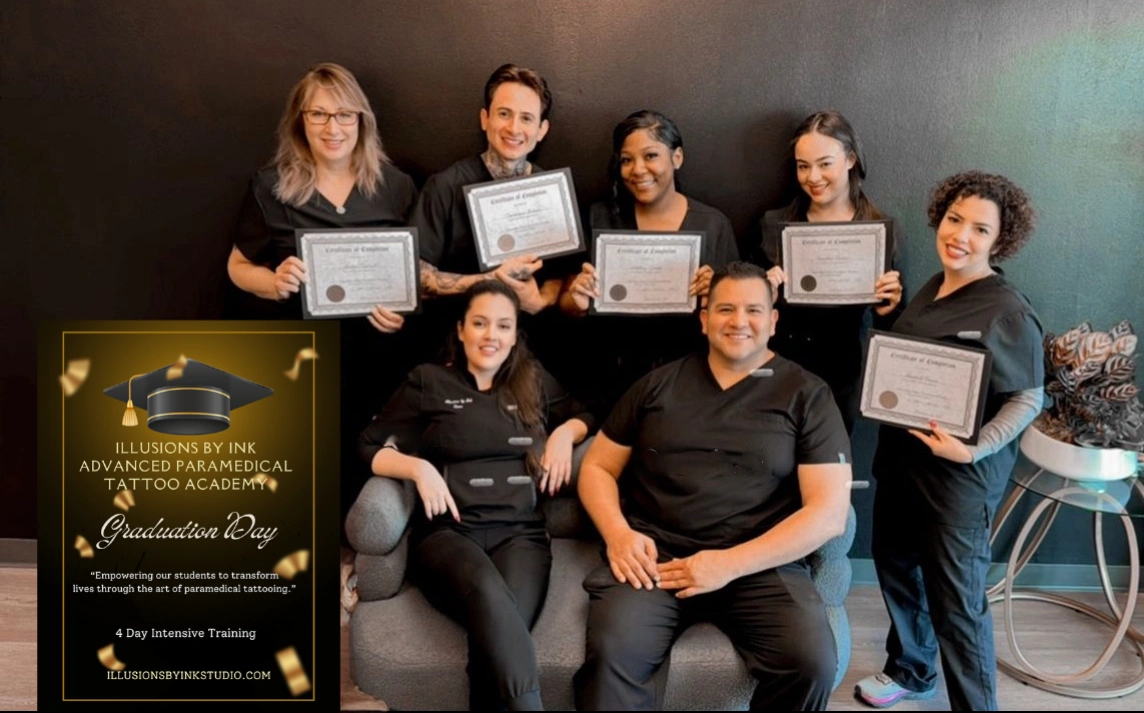
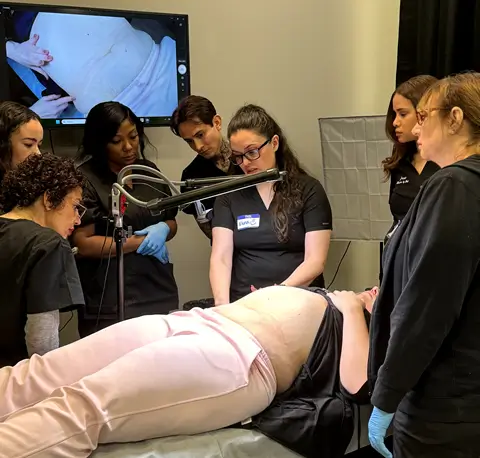
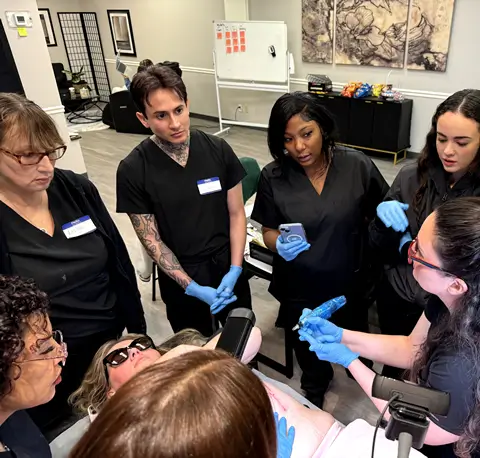
What Sets Illusions By Ink Studio Apart: A World-Class Approach to Paramedical Tattoo Training
Illusions By Ink Studio provides training that focuses on real-world skills. This prepares you to succeed in the paramedical tattoo field. From day one, our program immerses you in challenging, complex cases that reflect the demands of a professional studio. With help from skilled professionals, you will learn techniques that focus on accuracy and creativity. You will also understand each client’s unique needs. This hands-on approach prepares you to handle different real-world situations with confidence and skill.
What truly sets us apart is our dedication to providing cutting-edge resources and tailored support. Trainees use the latest tattooing technology and new methods. They get direct feedback that helps improve their skills and client care. Our instructors bring years of expertise, sharing insights that enhance both technical mastery and professional growth. Our program focuses on what matters most. We help you build your skills, expand your services, and become a leader in the paramedical tattoo industry.
A message from our Master Trainer
If I can do it anybody can do it! Click the link to hear my story.
Illusions By Ink Studio: Superior Paramedical Tattoo Training with Dedicated Mentorship
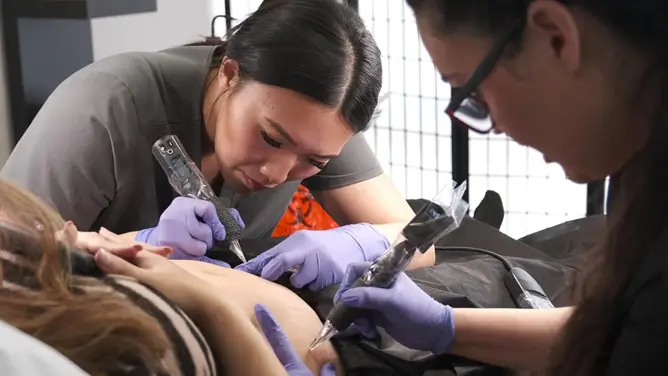
At Illusions By Ink Studio, our paramedical tattoo training class is designed to provide students with the most advanced techniques and global perspectives in camouflage tattooing. We’re committed to incorporating insights and methods from around the world, ensuring that our students receive a truly diverse education. With an emphasis on mastery and precision, our curriculum includes specialized techniques drawn from international practices, giving our students an edge in offering their clients the highest standards of artistry and care. This approach means you’re not just learning the essentials but also gaining a global perspective that allows you to bring innovative techniques to every client.
Our training is distinguished by personalized mentorship and ongoing support, making Illusions By Ink Studio a trusted partner on your career journey. Throughout the paramedical tattoo courses, our experienced instructors provide one-on-one guidance, helping you refine your skills and develop your unique style. We also offer ongoing coaching and support to ensure your success even after the training ends. Whether you’re enhancing your expertise or just starting in the field of paramedical tattooing, Illusions By Ink Studio is dedicated to helping you thrive, with a network of professionals and continuous resources that enable you to stay at the forefront of this evolving industry.
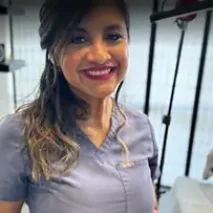
I drove up from San Antonio to take her amazing 4 day course! Elena is the best! The hands on experience you get sets them apart from anyone else! You will leave this course feeling confident & ready to rock! Definitely worth it…. Highly recommended!
IRIS ZELLER

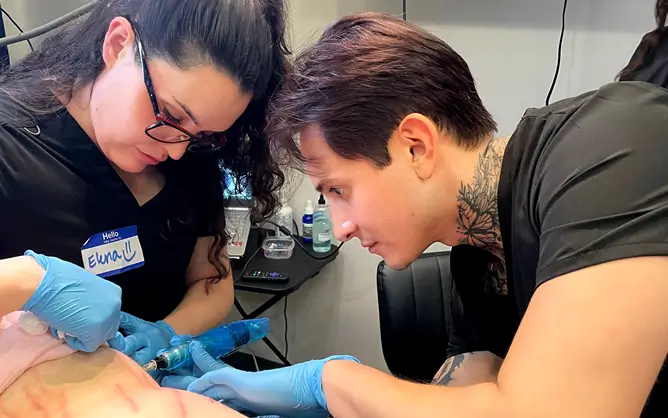


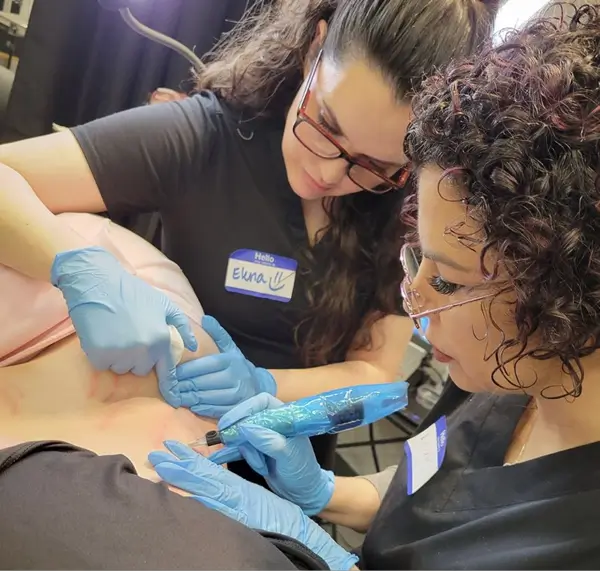

Comprehensive Paramedical Tattoo Training Kit: Equip Yourself for Success
Professional-Grade Tattoo Machine:
This high-quality, reliable, and precision-designed tattoo machine gives students the confidence to create consistent and natural-looking results.
Wide Range of Ink Shades:
A versatile selection of ink shades is included, offering students the tools to match a wide array of skin tones with accuracy and subtlety.
Realistic Practice Skins:
Practice makes perfect! These synthetic skins provide students with a safe, realistic surface to hone their technique before working with clients.
Full Set of Essential Supplies:
Every kit comes with sterile needles, gloves, and other professional-grade materials, ensuring students have everything needed for a safe, efficient practice.
Frequently Asked Questions About Paramedical Tattoo Training with Illusions By Ink Studio
What does the paramedical tattoo training program cover?
Our program covers comprehensive techniques for camouflage tattooing, including scar camouflage, skin color matching, pigment selection, and realistic shading methods. We also delve into client consultation, aftercare, and safety protocols.
Who can enroll in the paramedical tattoo training course?
The course is ideal for aspiring tattoo artists, licensed estheticians, permanent makeup artists, and professionals in the cosmetic, beauty, or medical industry who wish to expand their skills with paramedical tattooing.
How long is the paramedical tattoo training program?
Our training program is structured over multiple sessions to allow for in-depth learning, practical applications, and personalized feedback. Course duration varies depending on the training package selected.
Will I receive hands-on practice during training?
Yes, our program includes extensive hands-on practice sessions under the guidance of experienced instructors. This allows students to gain real-world experience and master techniques with confidence.
What qualifications do I receive after completing the training?
Graduates receive a certificate of completion from Illusions By Ink Studio, validating their skills and knowledge in paramedical tattooing, and are equipped to start practicing on their own clients.
How can paramedical tattooing benefit my career?
Paramedical tattooing is a growing field with increasing demand. By adding camouflage tattooing skills to your offerings, you can help clients regain confidence and broaden your services, making you more competitive and versatile in the industry.
Paramedical Tattoo Training Videos - BTS
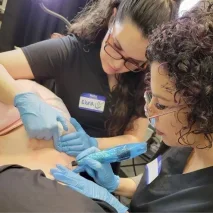
I first came to this studio to take care of my own scars and ended up taking Elena’s training because I truly believe what she’s doing makes a difference in people’s lives.
Her course was amazing! She gives awesome education along with tons of hands-on hours on actual models! There’s no way you’ll find a more immerssive course with continued support from an awesome expert!
L B
Training Packages
CAMOUFLAGE PRO
Master the Art of Scar Camouflage with Our All-Inclusive Training Program
Unlock Your Potential with the Industry’s Best Resources, Techniques, and Expertise
- Comprehensive Starter Kit:
Dive into practice immediately with your essential scar camouflage equipment, including a wireless tattoo pen, specialized needles, skin tone inks and modifiers, and other necessary tools (total value: $800). - In-depth Color Theory Guide:
Master the art of skin tone analysis and ink selection with our detailed training manual. Learn to identify undertones, overtones, and create seamless color matches for flawless camouflage results. - Versatile Skillset Development:
Become proficient in both traditional ink-based and innovative inkless camouflage techniques, expanding your service options for diverse client needs. - Client Care Expertise:
Ensure client safety and optimal results with thorough pre-care and post-care guidance, plus a trusted vendor list for reliable, high-quality supplies. - Advanced Shading for Realistic Results:
Learn specialized shading techniques to flawlessly camouflage both scars and stretch marks, achieving natural-looking, confidence-boosting outcomes. - Protect Your Business:
Gain essential legal knowledge with provided consent forms, safeguarding both you and your clients. - Pricing for Success:
Develop a profitable pricing strategy with our suggested rate sheet, ensuring you’re compensated fairly for your expertise. - Elena’s Skin Matching Secrets:
Unlock the secrets to Elena Sanchez’s perfect skin tone matching techniques, a hallmark of high-quality camouflage work. - Industry-leading Hands-On Mastery with Live Models:
Build confidence and refine your technique through extensive hands-on practice with live models, addressing a variety of scar and stretch mark types. - Personalized Success Plan:
Receive expert feedback and a tailored observation report, highlighting your strengths and guiding your continued growth as a camouflage artist. - Professional Certificate:
Earn your Paramedical Tattoo Training Certification, demonstrating your mastery of the Illusions by Ink Studio Stretch Mark and Scar Camouflage Technique.
Training Dates
- Jul (Full)
- Aug (1 spot avail)
- Sep (2 spots avail)
$7950
limited seats available
DEPOSITS ARE NON REFUNDABLE
CAMOUFLAGE PRO ELITE
One-on-One Private Training with Elena Sanchez
Elevate your expertise with this exclusive 5 days, one-on-one training program, designed for those who want personalized, hands-on coaching directly from Elena Sanchez, a leading expert in scar camouflage artistry. This unique opportunity is perfect for artists who are serious about refining their craft and unlocking their full potential.
- Enhanced Pro Kit:
Dive into practice immediately with your essential scar camouflage equipment, including a wireless tattoo pen, specialized needles, skin tone inks and modifiers, and other necessary tools (total value: $1,000). - In-depth Color Theory Guide:
Focus on advanced techniques like ink-based and inkless camouflage, customized to meet your individual goals and challenges.
- Exclusive Access to Elena’s Expertise:
Become proficient in both traditional ink-based and innovative inkless camouflage techniques, expanding your service options for diverse client needs. - Versatile Skillset Development:
Become proficient in both traditional ink-based and innovative inkless camouflage techniques, expanding your service options for diverse client needs. - Client Care Expertise:
Ensure client safety and optimal results with thorough pre-care and post-care guidance, plus a trusted vendor list for reliable, high-quality supplies. - Advanced Shading for Realistic Results:
Learn specialized shading techniques to flawlessly camouflage both scars and stretch marks, achieving natural-looking, confidence-boosting outcomes. - Protect Your Business:
Gain essential legal knowledge with provided consent forms, safeguarding both you and your clients. - Pricing for Success:
Develop a profitable pricing strategy with our suggested rate sheet, ensuring you’re compensated fairly for your expertise. - Business and Marketing Success Strategies:
Position yourself as a leader in the field with professional pricing plans, consent forms, and proven marketing techniques.
- Elena’s Skin Matching Secrets:
Unlock the secrets to Elena Sanchez’s perfect skin tone matching techniques, a hallmark of high-quality camouflage work. - Industry-leading Hands-On Mastery with Live Models:
Gain unparalleled real-world experience, building confidence as you tackle diverse cases under Elena’s direct supervision.
- Customized Success Plan:
Receive expert feedback tailored to your specific goals and skill level, ensuring you maximize your learning potential. - Professional Certificate:
Complete the program with an industry-recognized certificate that highlights your mastery of scar camouflage techniques.
Limited Spots Available for 2025 – Secure Yours Before the Price Increases!
Due to the highly personalized nature of this program, availability is extremely limited, and demand is high. Spots are filling quickly on a first-come, first-served basis
Training Dates
- Please Call 916-912-3958
$9950
Limited spots AVAILABLE FOR 2025
DEPOSITS ARE NON REFUNDABLE
MOBILE MASTERY SERIES
On-Location Training The Comes to You
Bring Elena Sanchez to your business for the ultimate scar camouflage training experience — without sacrificing your time, business, or convenience. This exclusive on-site program is designed for busy professionals who want private, high-level training in the comfort of their own space.
- 5 Days of One-on-One Training in Your Business:
Enjoy hands-on guidance, real client work, and live observation — without ever leaving your business behind..
- Luxury Pro Training Kit :
Includes everything needed to perform both ink-based and inkless scar camouflage — delivered and set up on-site.
Elena’s On-Site Skin Matching & Scar Correction Protocols:
Work with real cases under Elena’s supervision, applying her exact process in your environment with your ideal clientele in mind.
Premium Curriculum, Custom to Your Business Needs:
From intake to pricing, protocols to pigment selection — everything is adapted to your business structure and local market.
- Live Model Training on Real Clients:
Gain immediate confidence by treating live models under Elena’s direct oversight.
- Client Experience Optimization:
Learn how to replicate Illusions by Ink’s five-star experience from the first consultation to final results.
- Protect Your Business:
Gain essential legal knowledge with provided consent forms, safeguarding both you and your clients. - Business & Brand Strategy for Business Owners:
Develop a profitable pricing strategy with our suggested rate sheet, ensuring you’re compensated fairly for your expertise. - Business and Marketing Success Strategies:
Position yourself as a leader in the field with professional pricing plans, consent forms, and proven marketing techniques.
- Certificate of Completion:
Receive your Mobile Mastery Series Certification from Illusions by Ink Studio, showcasing your readiness to offer elite-level camouflage tattooing.
- Industry-leading Hands-On Mastery with Live Models:
Gain unparalleled real-world experience, building confidence as you tackle diverse cases under Elena’s direct supervision.
Travel Surcharge Notice: Travel fees are based on geographic location and will be quoted during your consultation.
- Professional Certificate:
Complete the program with an industry-recognized certificate that highlights your mastery of scar camouflage techniques.
- Limited Availability – Mobile Sessions Book Quickly:
Due to Elena’s service schedule and high demand, Mobile Mastery Series trainings are limited and reviewed by application.
Limited Availability — Mobile Sessions Book Quickly:
Due to Elena’s service schedule and high demand, Mobile Mastery Series trainings are limited and reviewed by application.
Training Dates
- Please Call 916-912-3958
$9950
Limited spots AVAILABLE FOR 2025 + Travel surcharge
DEPOSITS ARE NON REFUNDABLE

I came all the way from AZ for this Scar Camouflage training after doing research for the most comprehensive hands on training and this is it! We learned detailed color matching and we had so much hands on! I feel well eqipped to provide exceptional treatment to future clients. The course was informative and fun too! I recommend training with Elena at Illusions by Ink in Irving TX!
ERICA CUSPARD
Meet Elena
THE PARAMEDICAL TATTOO ARTIST WHOM YOU CAN TRUST
Hi, I am Elena and I am a professional paramedical tattoo artist.

My knowledge, experience, and hard work help me make you feel better about your appearance. I want to restore your confidence and bring you closer to a happy life. Believe me, I know how you feel because every case I work with I take close to my heart. Each person, each story, each case is very special to me and I truly care.
When I offer paramedical tattoo services, I work hard to make my clients feel comfortable and safe. Believe me you are in reliable hands. You can share your story with me freely. I understand how important it is to talk about your skin or hair issues. Most importantly, you will find full understanding and support from my side.
I have this deep urge to help people and I will be honored if you will find the strength to share your situation with me. As a seasoned professional, I can provide the ultimate treatment that will help you to feel good about your appearance so that you can begin to love yourself again.
Without hesitation, I can tell that I take the most complicated cases that other professionals denied working with. I am confident in my skills and I know for fact that when you are in the reliable hands of a dedicated and well experienced professional, paramedical tattooing creates miracles. Yes, maybe I cannot help to heal your soul’s scars but I can do something incredible with your skin.
I provide the wide range of paramedical tattoo services and will be happy to help you to improve your self-confidence. I work with all body parts, even if you have some issues with the most intimate places of your body. I have years of experience with every imaginable body part including private parts and have 100% five-star results after work was done.
Student Testimonials Hear directly from our graduates!
Christina Jasim
Erica Cuspard
I came all the way from AZ for this Scar Camouflage training after doing research for the most comprehensive hands on training and this is it! We learned detailed color matching and we had so much hands on! I feel well eqipped to provide exceptional treatment to future clients. The course was informative and fun too! I recommend training with Elena at Illusions by Ink in Irving TX!
Leslye Dietrich
They say to continue to learn new things. You’re never too old to learn something new. There aren’t enough words to express how wonderful Elena is at her art and as an instructor. Thank you for sharing your love of paramedical tattooing with me.
melissa munoz
Thank you for a great experience! Great presentation style with lots of opportunities to ask questions and talk about real life hands on experience which all made for a really enjoyable and informative course.” “This has more than met my expectations.” “A wonderfully practical course – both personally and professionally. Elena is the best❤️
L B
Ashley Grant
For me, Illusions by Ink Studio didn’t just change my life once, they did it twice. First as a client and then as a trainee, giving me tools to begin gaining the experience I need to be on the path to becoming one of the best!!! Elena motivates everyone around her, is very knowledgeable and sets the bar in every aspect so high, and I value that. Additionally, her Whole Team, including Albert and Jazzie are on point, knowledgeable, and super helpful. I love it here!!!
Dominique Serrano
Vanessa Morante
I was Elena’s student and I think she did BEYOND amazing! I felt completely comfortable walking out the door with the skills she taught me . Elena made everything so easy and super understandable. If she does more training in addition to what we did ….I’m definitely coming back . Thank you so much ! ♥️
Apply Today to Transform Your Career with Paramedical Tattoo Training and Earn Your Certification
Ready to make a lasting impact in the world of aesthetics and medical tattooing? By enrolling in our comprehensive paramedical tattoo course, you’ll gain hands-on experience and the knowledge needed to provide life-changing services for clients. Our expert-led courses cover everything from camouflage tattooing techniques to the artistry of scar reduction, empowering you to create results that restore confidence and enhance the lives of those you work with. This program helps you gain advanced skills and personalized coaching. You will receive the support you need to succeed as a certified paramedical tattoo artist.
Earning your paramedical tattoo training certification opens doors to a unique and rewarding career path where you can make a difference every day. Whether you’re looking to build a new business or add specialized services like micropigmentation, stretch mark, or scar camouflage to your existing practice, certification from our program is recognized for its quality and thorough approach. With help from experienced instructors, you will graduate with a certification. You will also gain the confidence, knowledge, and skills to change lives through your craft.
Don’t miss this opportunity to become a skilled paramedical tattoo artist, where each mark you make has the power to change lives. Apply today to start your journey in learning paramedical tattooing. Join a community that is dedicated to helping others with this amazing skill.
TRANSFORM LIVES AND MASTER CAMOUFLAGE TATTOOING WITH ILLUSIONS BY INK.
Click to apply and start your journey. Provide your details and preferred dates, and we’ll be in touch after reviewing your application.
*Receive an automated email confirmation upon applying.
Embrace this opportunity to excel in a field where artistry meets empowerment, with Illusions by Ink leading the way.
